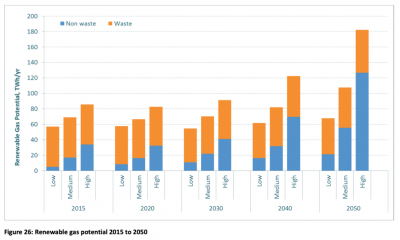By the end of the 2010s, the limits to the potential of biomethane, and the absurdity of NG/E&Y’s 2009 projections were unavoidable. Biomethane was contributing 0.7% of the UK’s gas. Electrification of heat wasn’t doing much better. Solid biomass was dominating the relatively-limited amount of renewable heat that the UK had deployed.
Following the separation of the gas and electricity networks, Cadent were the successor to National Grid as the operator of the gas grid. They commissioned Anthesis and E4Tech to produce a “Technical Report” in 2017 on “Review of Bioenergy Potential”.[1] Unsurprisingly, this judged that the potential was large and that most of that potential could be used to produce renewable gas.
Despite attempts to re-stimulate the technology by reversing earlier RHI degressions, UK production of biomethane remains around 3 TWh p.a. as of early 2020.[2]
The study’s range of 68-183 TWh in 2050 is composed of:
- 47-56 TWh from waste feedstocks, with 83% of this coming from bioSNG and 17% from biomethane via AD; and
- 21-127 TWh from non-waste feedstock, with 97% of this coming energy crops, short rotation forestry and wood/forestry residues converted to bioSNG and the remaining 3% from biomethane via anaerobic digestion of wet manures and macro-algae.
In other words, they are still hanging their hat on gasification for most of this gas, and have significantly beefed up the assumed contribution of energy crops for gasifying, presumably recognising that the claims for the potential of waste feedstocks had been falsified by events after the 2009 report.
Like the 2009 report, this new report is being cited in other studies as a credible piece of academic research.[3]
Meanwhile, National Grid is promoting a model of (roughly) 60% electrification and 40% hydrogen and biogas (replacing natural gas) for the UK’s 2050 heat supplies.[4] This too is being cited in studies by academics, pressure groups, consultants and government bodies.
The annual output of heat pumps in the RHI is around 170 GWh (<0.03% of UK heat demand).[5] The only hydrogen heating in the UK is in experimental projects.
One could carry out a similar analysis of the claims in these studies, but ultimately only history will tell, as it did when we reached the 2020 forecast date for the 2009 study. As we have demonstrated, those projections were objectively improbable in 2009, as are the current projections from Cadent and National Grid ten years later. They also served the same, obvious commercial purpose.
Will our policymakers continue to believe self-serving projections simply because they are produced by operators of our national infrastructure, who are big enough to have the resources to produce and promote them? Or will they learn to rely instead on sound, technology-neutral economic policy that supports continuous market competition, discovery and innovation, and does not attempt to pick winners on the strength of motivated projections of the unknowable future?
[2] Comparing the cumulative totals for biomethane in copies of Ofgem’s RHI Public Report downloaded in early 2020 and early 2019. https://rhi.ofgem.gov.uk/Public/ExternalReportDetail.aspx?RP=RHIPublicR…
[3] e.g. BEIS, Clean Growth – Transforming Heating (Overview of current evidence) (Dec 2018)
[4] e.g. Future Energy Scenarios (Jul 2019) http://fes.nationalgrid.com/media/1409/fes-2019.pdf and their Future of Gas studies (https://futureofgas.uk/homepage/).
[5] The Digest of UK Energy Statistics records 979 ktoe (11.4 TWh) by the expedient of adding around 1,000 ktoe to the previous total in 2018 (backdated to 2015) by redefining commercial air-conditioning units as “Reversible Air-to-Air Heat Pumps” and making ambitious claims for their efficiency and utilisation for heating purposes. The RHI figure indicates the amount of heat pumps heating that has actually been added since 2011.

